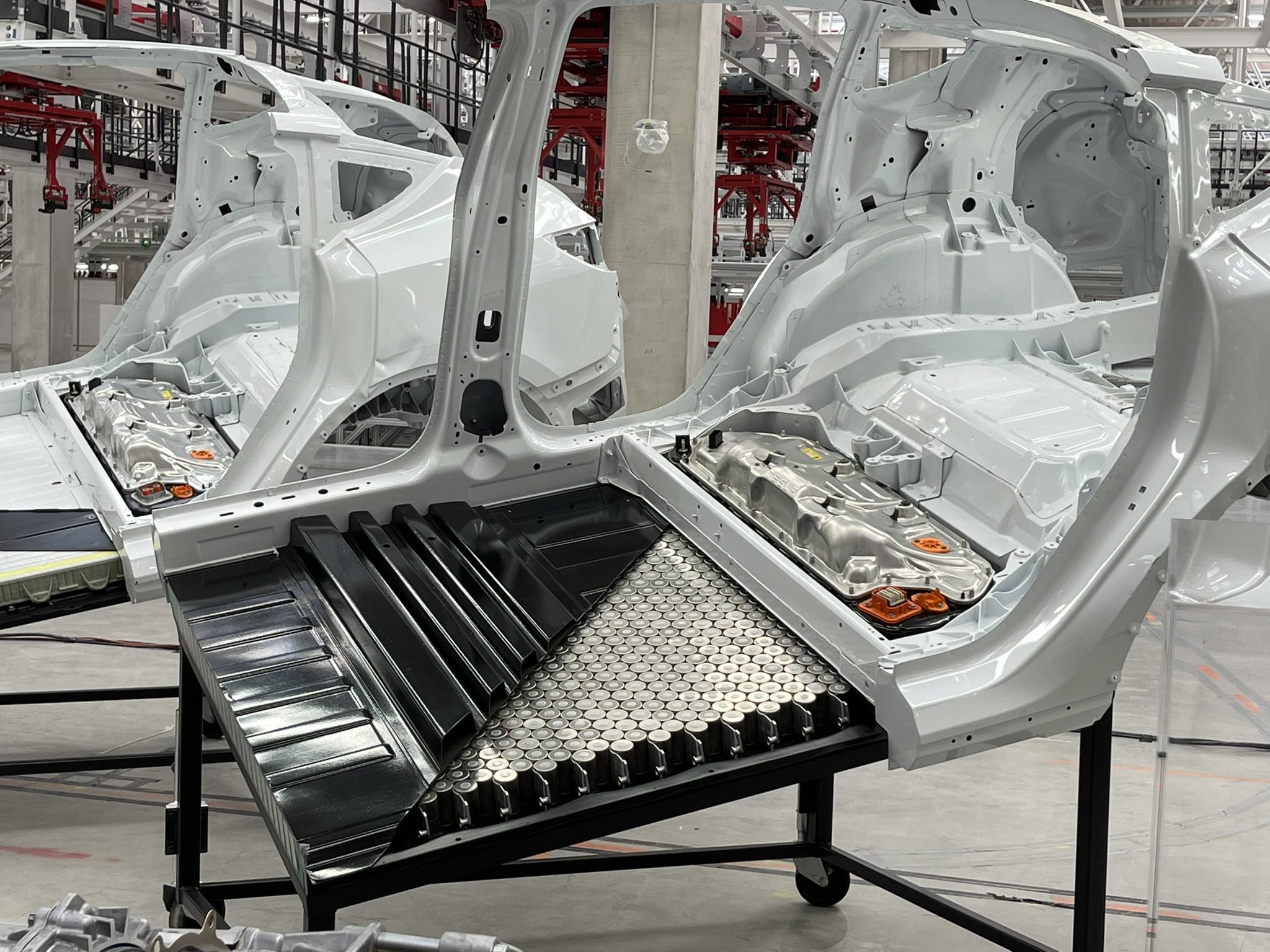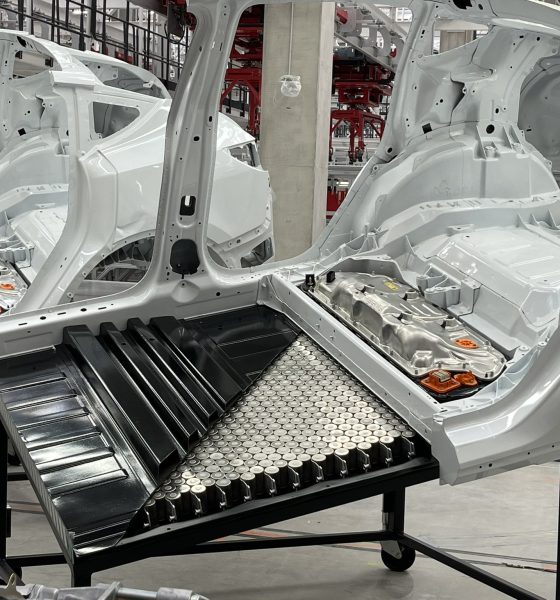

News
Tesla’s 4680 battery ramp may experience a “Death Valley” start, but it will be overcome: expert
To state that Tesla’s future lies in the success or failure of the 4680 battery is not an understatement. Without 4680 cells, Tesla’s efforts to create an affordable car at a price point beneath the Model 3 would likely be for naught. But if the company succeeds in ramping the production of its 4680 cells, Tesla could very well pave the way for electric vehicles to become the dominant form of personal transportation in the decades to come.
Getting there would not be easy. Tesla formally announced its 4680 battery project in September 2020, and since then, the company has been working hard to ramp the production of the next-generation cell. Tesla produced its one millionth 4680 cell in January. That’s a milestone on its own, but it does show that the company still has a long way to go before it can fully ramp its new battery.
Industry researcher Benchmark Mineral Intelligence estimates that one million 4680 cells are enough for just about 1,200 Model Ys. Tesla intends to produce far more than that per week in Gigafactory Texas alone.
Tesla’s 4680 cells are not designed like conventional batteries, and they are not made like traditional cells either. Tesla plans to use a new manufacturing technology called dry electrode coating, which was obtained from the company’s acquisition of Maxwell Technologies in 2019. Dry electrode manufacturing would allow Tesla to skip a conventional step in traditional battery production, which should lower costs significantly.
While Tesla acquired the technology, the innovations involved in the mass-production of 4680 cells using dry electrode coating are a massive challenge. Elon Musk has noted that the factory equipment for the process alone “doesn’t exist,” so they still have to be made.
Shirley Meng, a University of Chicago professor who previously worked with Maxwell, noted that Tesla’s 4680 battery efforts could change the industry. She also emphasized that Tesla’s challenges in mass-producing the next-generation battery would be immense. “He (Elon Musk) is changing the way how battery manufacturing is done. It’s really, really difficult to manufacture at a speed and at scale,” she said. She also stated that Tesla may have to experience a “Death Valley” start to scaling up the dry electrode process for 4680 cells.
She does, however, believe that Tesla would overcome these difficulties.
Other experts and longtime followers of the company seem to agree on the difficulty involved in developing and ramping a new type of battery cell. Caspar Rawles, chief data officer at Benchmark Mineral Intelligence, noted that fine-tuning the production equipment for battery production alone is an extremely long process, and one that challenges even the industry’s veterans. “There’s a very long process of fine-tuning the equipment before you can get to volume production. Battery production is hard, even hard for experienced suppliers,” he said.
This definitely seems to be the case with Panasonic. The Japanese tech conglomerate has been a longtime partner of Tesla, and it already operates Gigafactory Nevada with the EV maker. However, recent comments from Kazuo Tadanobu, the CEO of Panasonic’s energy division, revealed that even Panasonic had to take its time to develop its 4680 batteries. Tadanobu noted that Tesla has already deemed Panasonic’s 4680 cells viable for use, but mass production of the new batteries is still expected to start by the fiscal year ending in March 2024.
Tesla’s 4680 cells are expected to be used in vehicles like the Tesla Semi, the Cybertruck, and the company’s flagship supercar, the new Roadster. The next-generation batteries are also expected to be utilized in Tesla’s next big project, the production of an affordable $25,000 electric car.
*Quotes courtesy of Reuters.
Don’t hesitate to contact us with news tips. Just send a message to simon@teslarati.com to give us a heads up.

News
Tesla FSD (Supervised) v14.2.2 starts rolling out
The update focuses on smoother real-world performance, better obstacle awareness, and precise end-of-trip routing, among other improvements.

Tesla has started rolling out Full Self-Driving (Supervised) v14.2.2, bringing further refinements to its most advanced driver-assist system. The new FSD update focuses on smoother real-world performance, better obstacle awareness, and precise end-of-trip routing, among other improvements.
Key FSD v14.2.2 improvements
As noted by Not a Tesla App, FSD v14.2.2 upgrades the vision encoder neural network with higher resolution features, enhancing detection of emergency vehicles, road obstacles, and human gestures. New Arrival Options let users select preferred drop-off styles, such as Parking Lot, Street, Driveway, Parking Garage, or Curbside, with the navigation pin automatically adjusting to the user’s ideal spot for precision.
Other additions include pulling over for emergency vehicles, real-time vision-based detours for blocked roads, improved gate and debris handling, and extreme Speed Profiles for customized driving styles. Reliability gains cover fault recovery, residue alerts on the windshield, and automatic narrow-field camera washing for new 2026 Model Y units.
FSD v14.2.2 also boosts unprotected turns, lane changes, cut-ins, and school bus scenarios, among other things. Tesla also noted that users’ FSD statistics will be saved under Controls > Autopilot, which should help drivers easily view how much they are using FSD in their daily drives.
Key FSD v14.2.2 release notes
Full Self-Driving (Supervised) v14.2.2 includes:
- Upgraded the neural network vision encoder, leveraging higher resolution features to further improve scenarios like handling emergency vehicles, obstacles on the road, and human gestures.
- Added Arrival Options for you to select where FSD should park: in a Parking Lot, on the Street, in a Driveway, in a Parking Garage, or at the Curbside.
- Added handling to pull over or yield for emergency vehicles (e.g. police cars, fire trucks, ambulances).
- Added navigation and routing into the vision-based neural network for real-time handling of blocked roads and detours.
- Added additional Speed Profile to further customize driving style preference.
- Improved handling for static and dynamic gates.
- Improved offsetting for road debris (e.g. tires, tree branches, boxes).
- Improve handling of several scenarios, including unprotected turns, lane changes, vehicle cut-ins, and school buses.
- Improved FSD’s ability to manage system faults and recover smoothly from degraded operation for enhanced reliability.
- Added alerting for residue build-up on interior windshield that may impact front camera visibility. If affected, visit Service for cleaning!
- Added automatic narrow field washing to provide rapid and efficient front camera self-cleaning, and optimize aerodynamics wash at higher vehicle speed.
- Camera visibility can lead to increased attention monitoring sensitivity.
Upcoming Improvements:
- Overall smoothness and sentience.
- Parking spot selection and parking quality.
News
Tesla is not sparing any expense in ensuring the Cybercab is safe
Images shared by the longtime watcher showed 16 Cybercab prototypes parked near Giga Texas’ dedicated crash test facility.

The Tesla Cybercab could very well be the safest taxi on the road when it is released and deployed for public use. This was, at least, hinted at by the intensive safety tests that Tesla seems to be putting the autonomous two-seater through at its Giga Texas crash test facility.
Intensive crash tests
As per recent images from longtime Giga Texas watcher and drone operator Joe Tegtmeyer, Tesla seems to be very busy crash testing Cybercab units. Images shared by the longtime watcher showed 16 Cybercab prototypes parked near Giga Texas’ dedicated crash test facility just before the holidays.
Tegtmeyer’s aerial photos showed the prototypes clustered outside the factory’s testing building. Some uncovered Cybercabs showed notable damage and one even had its airbags engaged. With Cybercab production expected to start in about 130 days, it appears that Tesla is very busy ensuring that its autonomous two-seater ends up becoming the safest taxi on public roads.
Prioritizing safety
With no human driver controls, the Cybercab demands exceptional active and passive safety systems to protect occupants in any scenario. Considering Tesla’s reputation, it is then understandable that the company seems to be sparing no expense in ensuring that the Cybercab is as safe as possible.
Tesla’s focus on safety was recently highlighted when the Cybertruck achieved a Top Safety Pick+ rating from the Insurance Institute for Highway Safety (IIHS). This was a notable victory for the Cybertruck as critics have long claimed that the vehicle will be one of, if not the, most unsafe truck on the road due to its appearance. The vehicle’s Top Safety Pick+ rating, if any, simply proved that Tesla never neglects to make its cars as safe as possible, and that definitely includes the Cybercab.
Elon Musk
Tesla’s Elon Musk gives timeframe for FSD’s release in UAE
Provided that Musk’s timeframe proves accurate, FSD would be able to start saturating the Middle East, starting with the UAE, next year.

Tesla CEO Elon Musk stated on Monday that Full Self-Driving (Supervised) could launch in the United Arab Emirates (UAE) as soon as January 2026.
Provided that Musk’s timeframe proves accurate, FSD would be able to start saturating the Middle East, starting with the UAE, next year.
Musk’s estimate
In a post on X, UAE-based political analyst Ahmed Sharif Al Amiri asked Musk when FSD would arrive in the country, quoting an earlier post where the CEO encouraged users to try out FSD for themselves. Musk responded directly to the analyst’s inquiry.
“Hopefully, next month,” Musk wrote. The exchange attracted a lot of attention, with numerous X users sharing their excitement at the idea of FSD being brought to a new country. FSD (Supervised), after all, would likely allow hands-off highway driving, urban navigation, and parking under driver oversight in traffic-heavy cities such as Dubai and Abu Dhabi.
Musk’s comments about FSD’s arrival in the UAE were posted following his visit to the Middle Eastern country. Over the weekend, images were shared online of Musk meeting with UAE Defense Minister, Deputy Prime Minister, and Dubai Crown Prince HH Sheikh Hamdan bin Mohammed. Musk also posted a supportive message about the country, posting “UAE rocks!” on X.
FSD recognition
FSD has been getting quite a lot of support from foreign media outlets. FSD (Supervised) earned high marks from Germany’s largest car magazine, Auto Bild, during a test in Berlin’s challenging urban environment. The demonstration highlighted the system’s ability to handle dense traffic, construction sites, pedestrian crossings, and narrow streets with smooth, confident decision-making.
Journalist Robin Hornig was particularly struck by FSD’s superior perception and tireless attention, stating: “Tesla FSD Supervised sees more than I do. It doesn’t get distracted and never gets tired. I like to think I’m a good driver, but I can’t match this system’s all-around vision. It’s at its best when both work together: my experience and the Tesla’s constant attention.” Only one intervention was needed when the system misread a route, showcasing its maturity while relying on vision-only sensors and over-the-air learning.








